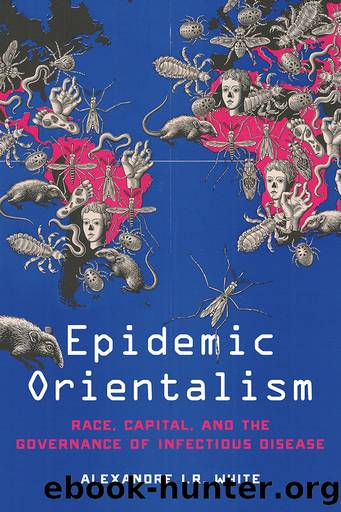Epidemic Orientalism by Alexandre I. R. White;

Author:Alexandre I. R. White;
Language: eng
Format: epub
Publisher: Stanford University Press
Published: 2022-06-15T00:00:00+00:00
Central to the focus of a future health organization was the reestablishment of epidemiological surveillance and the International Sanitary Conventions, motivated in no small part because of the epidemics that occurred after World War I and the anticipated mass migrations to occur at the close of the World War II. In October 1943, Dr. Oscar Forel, a noted psychotherapist and member of the French Resistance, sent a proposal for a postwar World Health Center. In his preamble to the proposal, he highlights that famine and epidemics in the years following the armistice of World War I killed more people than the war itself.63 At the center of his concerns for the postwar health future was the possibility for the rapid spread of disease as a result of large-scale resettlement of refugees and soldiers returning home:
From the armistice we will witness powerful migrations, the return of millions of deported human beings, voluntary exiles and evacuees. To this will be added the exodus of prison camps, the number of which already exceeds 5 million, and the liberation of concentration camps, internment and work camps. It is therefore necessary to foresee a movement of populations such as the history of humanity has never known. To this will be added enormous difficulties of transport, so that repatriates organized under conditions of proper hygiene can not be staggered for long months after the armistice. . . . It is likely to lead to a catastrophe if these millions spread in their way the contagious germs they carry, not to mention the risk of avoiding much more than the disorderly return of millions of men who, in 1919, relapsed pell-mell by any means, this poor motley crew, covered with vermin, carriers of contagious germs, contributed powerfully to the dissemination of post-1914â1918 epidemics, a cruel and costly experience, but minimal in comparison with what is developing in the shadow of this âtotal war.â64
In a memorandum originally drafted in 1942 but rewritten in 1944, Biraud lays out his arguments for the amalgamation of the major international health organizations (the LNHO and OIHP) into one. He justifies the amalgamation in no small part due to âthe tremendous task arising out of the sanitary situation in Eastern and Central Europeâ that âcould only be carried out by an international health institution with a broad statute and strong political and financial support fitting it for action.â65 The pressing concern for postwar reconstruction that both motivated the creation of the United Nations Relief and Rehabilitation Administration and undergirded much of the justification for the formulation of the United Nations also motivated actors beyond the orbit of the LNHOâs offices in Geneva in addition to a cadre of senior health figures at the international organizations. Though forced out as head of the LNHO and largely excluded from the planning of the WHO, physician, humanitarian, and evangelist of social medicine Ludwick Rajchman called for a United Nations Health Service in an article printed in the Free World, in which he advocated for a World
Download
This site does not store any files on its server. We only index and link to content provided by other sites. Please contact the content providers to delete copyright contents if any and email us, we'll remove relevant links or contents immediately.
Periodization Training for Sports by Tudor Bompa(7895)
Why We Sleep: Unlocking the Power of Sleep and Dreams by Matthew Walker(6321)
Paper Towns by Green John(4769)
The Immortal Life of Henrietta Lacks by Rebecca Skloot(4233)
The Sports Rules Book by Human Kinetics(4057)
Dynamic Alignment Through Imagery by Eric Franklin(3898)
ACSM's Complete Guide to Fitness & Health by ACSM(3801)
Kaplan MCAT Organic Chemistry Review: Created for MCAT 2015 (Kaplan Test Prep) by Kaplan(3782)
Introduction to Kinesiology by Shirl J. Hoffman(3608)
Livewired by David Eagleman(3520)
The River of Consciousness by Oliver Sacks(3392)
The Death of the Heart by Elizabeth Bowen(3320)
Alchemy and Alchemists by C. J. S. Thompson(3280)
Descartes' Error by Antonio Damasio(3151)
Bad Pharma by Ben Goldacre(3074)
The Gene: An Intimate History by Siddhartha Mukherjee(2905)
The Emperor of All Maladies: A Biography of Cancer by Siddhartha Mukherjee(2892)
The Fate of Rome: Climate, Disease, and the End of an Empire (The Princeton History of the Ancient World) by Kyle Harper(2845)
Kaplan MCAT Behavioral Sciences Review: Created for MCAT 2015 (Kaplan Test Prep) by Kaplan(2798)
